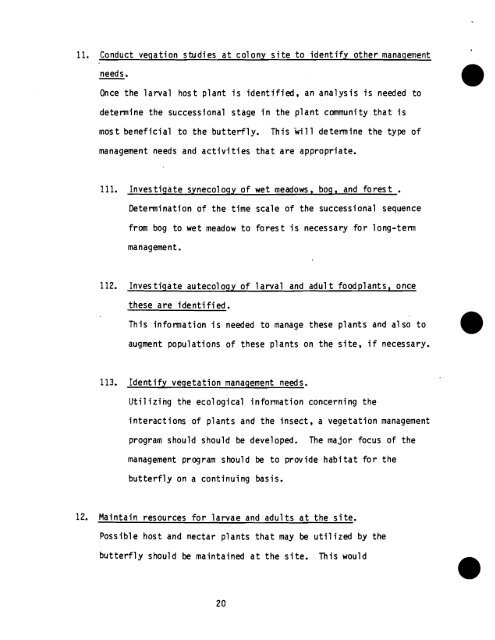Lotis Blue Butterfly Recovery Plan - U.S. Fish and Wildlife Service
Lotis Blue Butterfly Recovery Plan - U.S. Fish and Wildlife Service
Lotis Blue Butterfly Recovery Plan - U.S. Fish and Wildlife Service
Create successful ePaper yourself
Turn your PDF publications into a flip-book with our unique Google optimized e-Paper software.
11. Conduct vegation studies at colony site to identify other management<br />
needs.<br />
Once the larval host plant is identified, an analysis is needed to<br />
determine the successional stage in the plant community that is<br />
most beneficial to the butterfly. This 'will determine the type of<br />
management needs <strong>and</strong> activities that are appropriate.<br />
111. Investigate synecoloqy of wet meadows, boq, <strong>and</strong> forest .<br />
Determination of the time scale of the successional sequence<br />
from bog to wet meadow to forest is necessary for long-term<br />
management.<br />
112. Investigate autecol ogy of 1 awal <strong>and</strong> adul t foodpl ants, once<br />
these are identified.<br />
This information is needed to manage these plants <strong>and</strong> a1 so to<br />
augment populations of these plants on the site, if necessary.<br />
113. Identify vegetation management needs.<br />
Util izing the ecological information concerning the<br />
interactions of plants <strong>and</strong> the insect, a vegetation management<br />
program should should be developed. The major focus of the<br />
management program should be to provide habitat for the<br />
butterfly on a continuing basis.<br />
12. Maintain resources for larvae <strong>and</strong> adults at the site.<br />
Possible host <strong>and</strong> nectar plants that may be utilized by the<br />
butterfly should be maintained at the site. This would

















